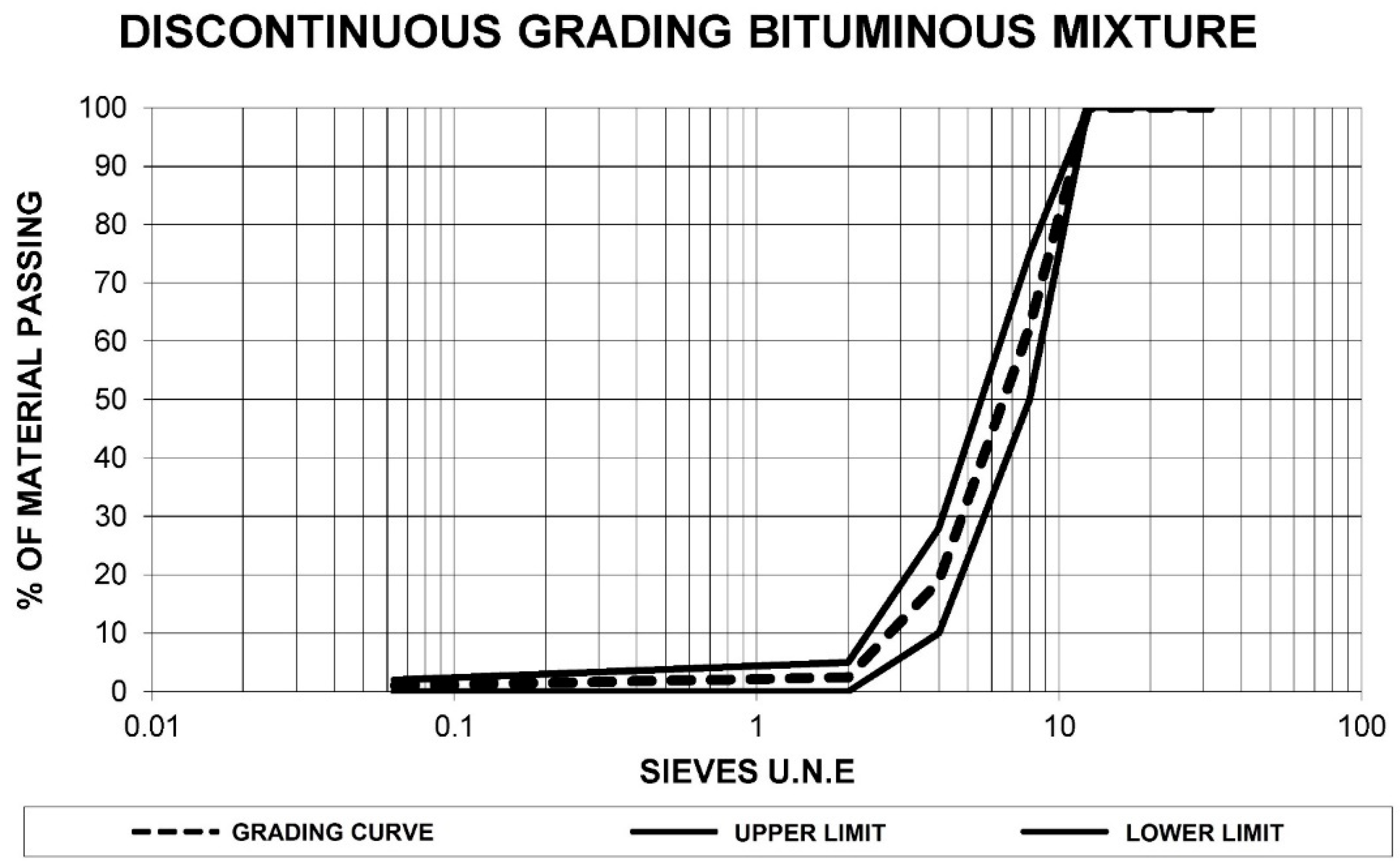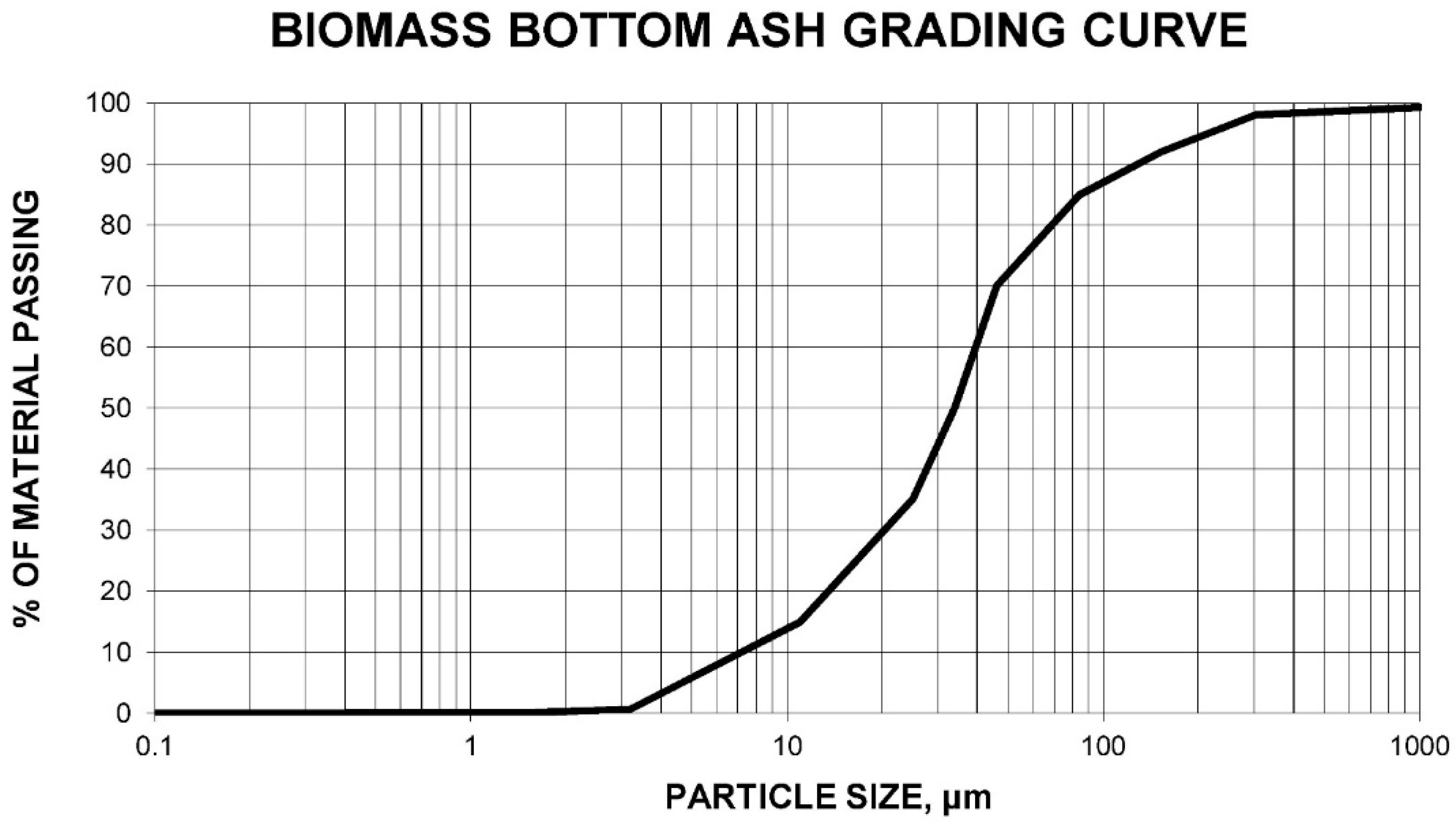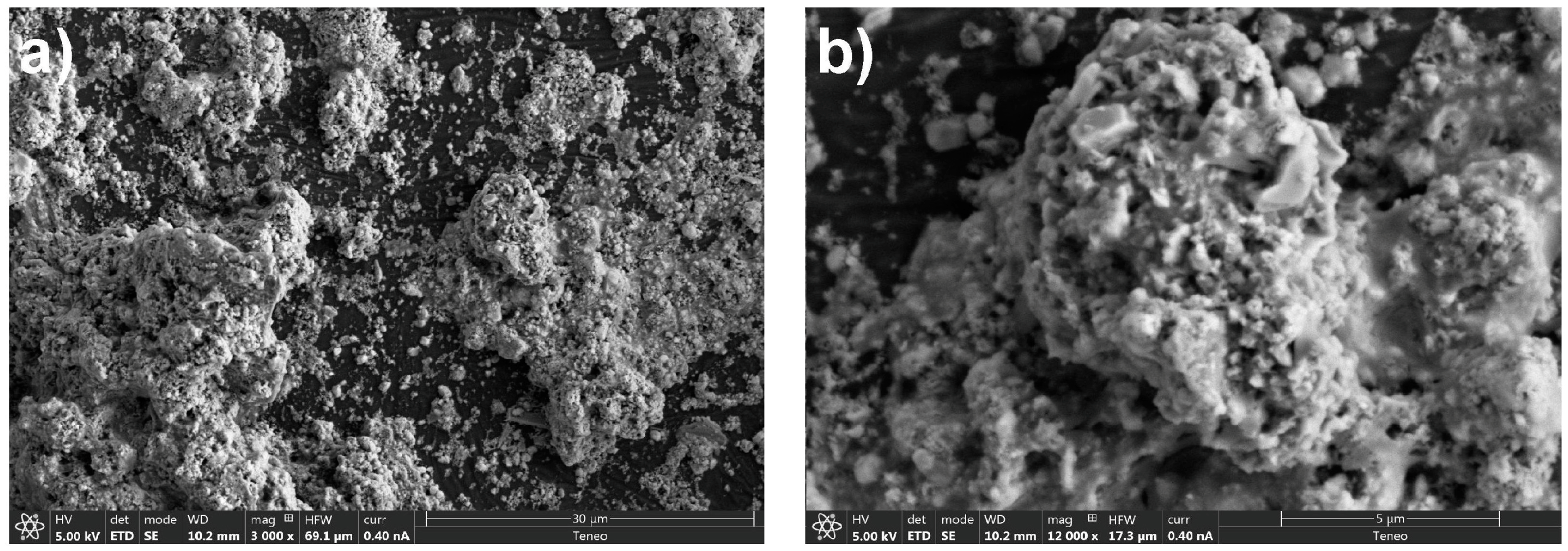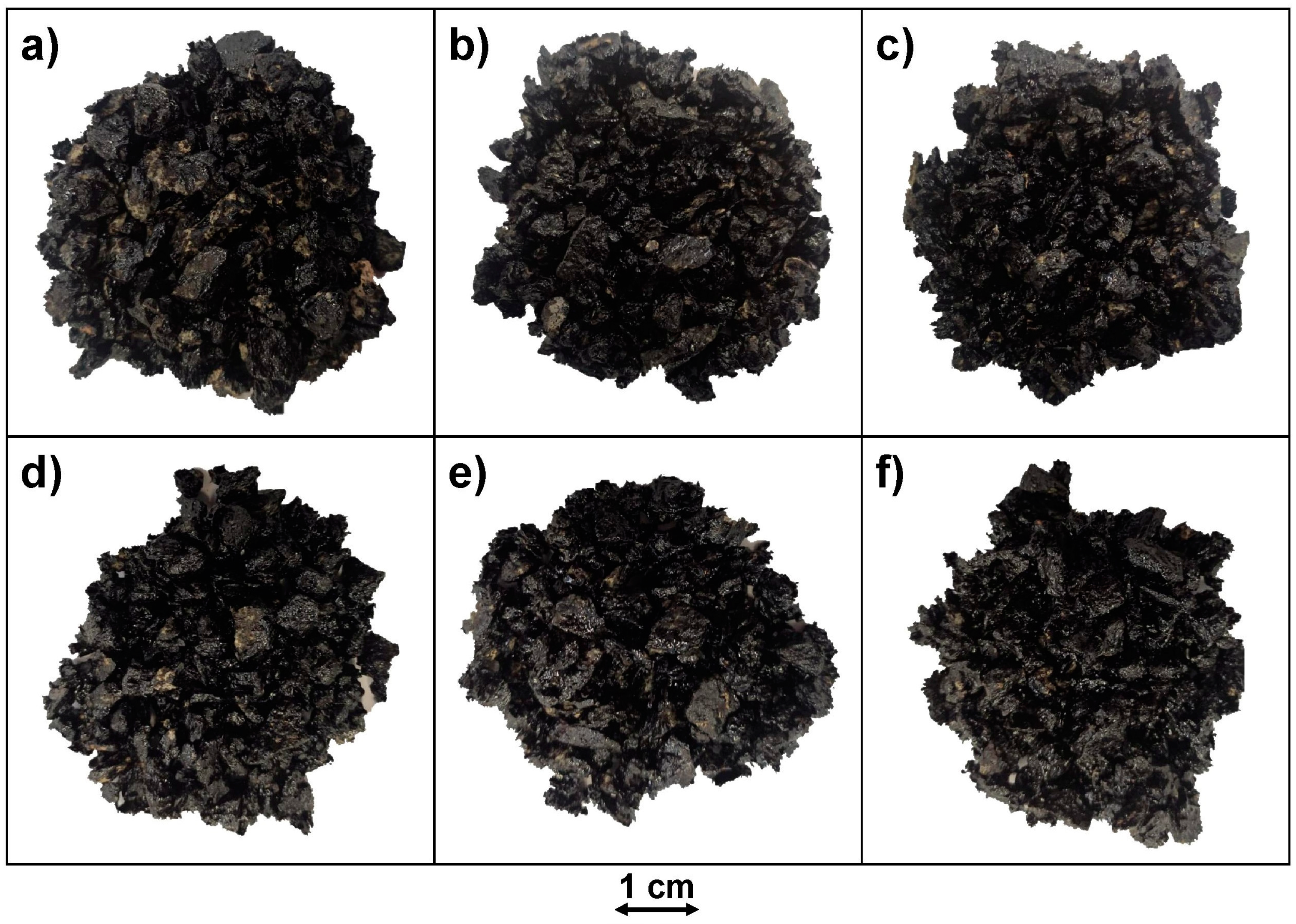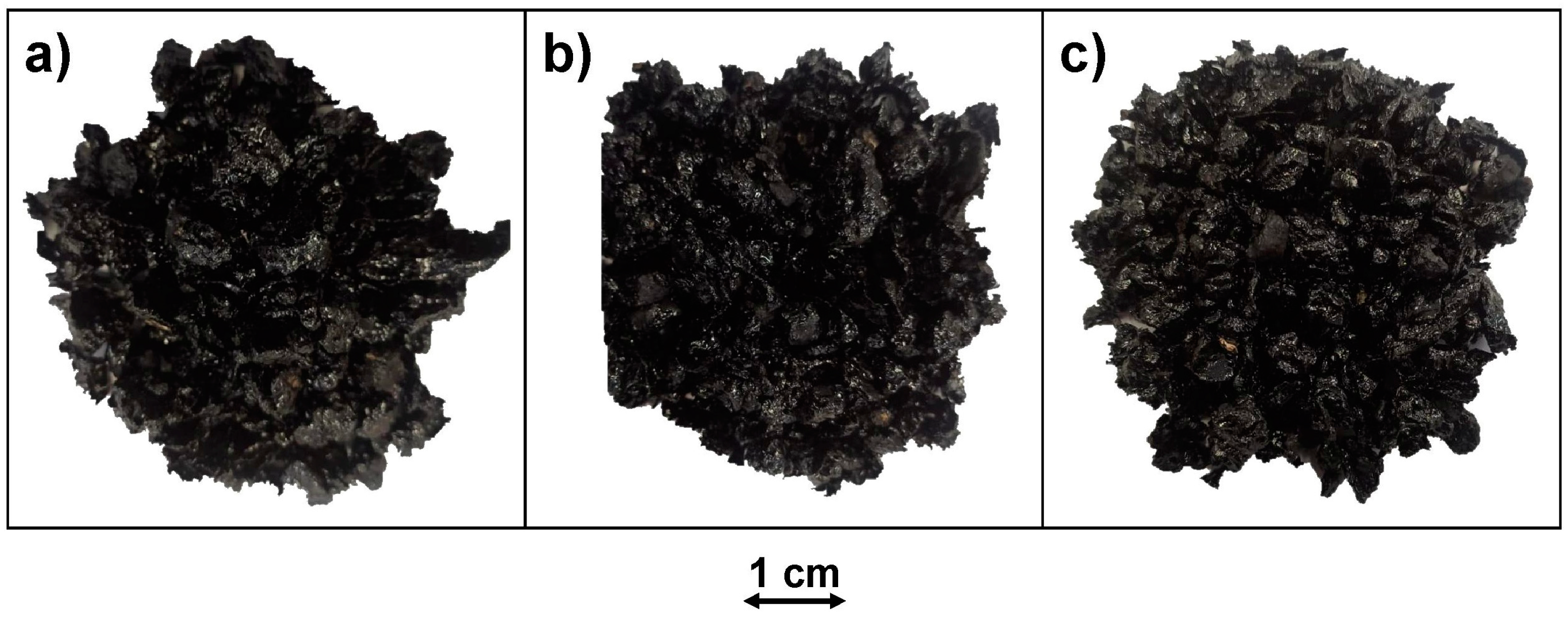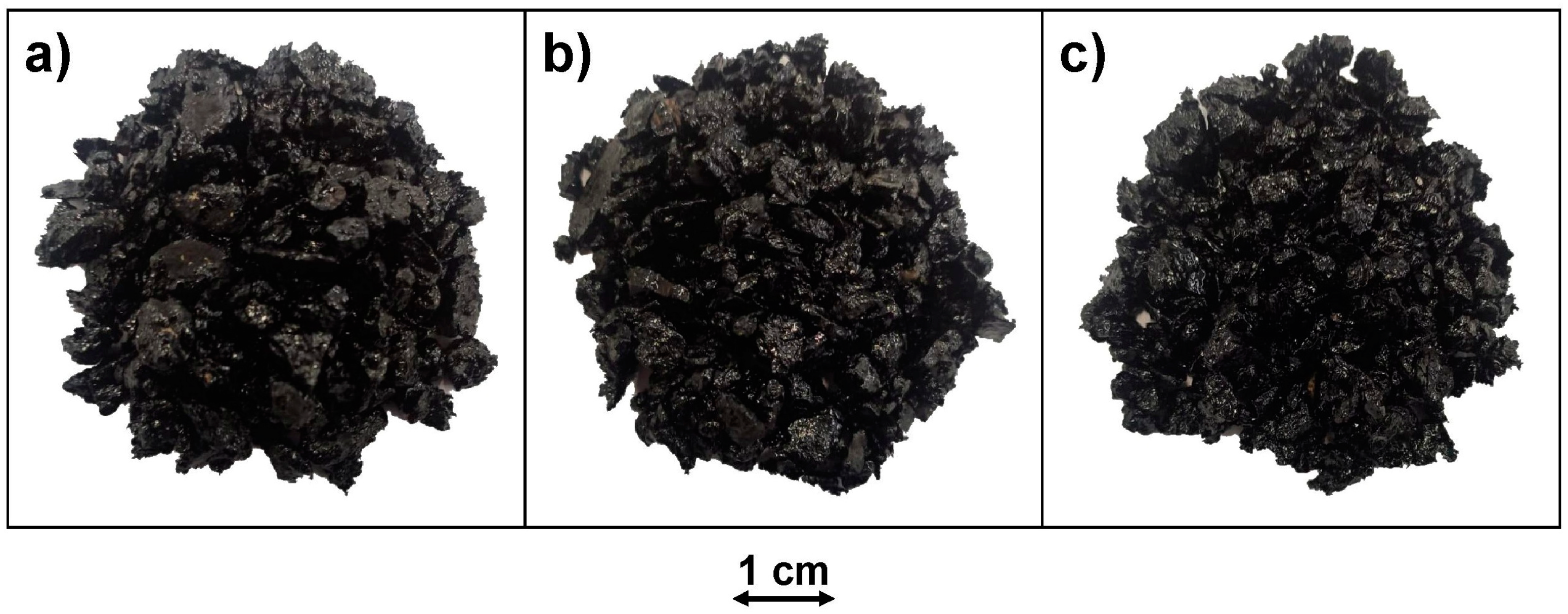The results of the tests mentioned in the methodology, as well as their discussion, are shown in the following sections.
3.1. Characterization of Biomass Bottom Ash
First, the chemical and physical characterization of the biomass bottom ash was carried out. As mentioned above, biomass bottom ash is a mainly inorganic material. Therefore, it is essential to perform the X-ray fluorescence test in order to identify the chemical elements of higher atomic weight that exist in the sample. The X-ray fluorescence test results, in the form of oxides, in the biomass bottom ash from this research, and other biomass bottom ashes that are derived from similar biomass [
60], olive-pruning remains and vegetable-fat wastes, are shown in
Table 5.
The X-ray fluorescence test reflects a high percentage of potassium. This is to be expected, taking into account that the biomass bottom ash analyzed comes from the combustion of almond shells and alpeorujo. This high percentage of potassium conditions further research into the use of ash as a fertilizer. At the same time, elements such as calcium, silicon, magnesium, and phosphorus are substantially present in the sample. These chemical elements are common in the biomass bottom ashes analyzed by different authors [
60] and do not pose a problem in themselves; moreover, they will condition the desired cementitious characteristics of the ashes corroborated in different investigations. In addition, there are also percentages of sulfur and chlorine, which were subsequently analyzed by leachate tests to determine whether contaminating leachates are produced.
It should be noted that chemical elements have greater or lesser activity, and even produce lesser or greater contamination, depending on the chemical compound in which they are combined. Therefore, it is essential to determine the chemical compounds present in the sample. This analysis is carried out by means of the X-ray diffraction test, reflecting the results shown in the diffractogram in
Figure 2.
The diffractogram of the biomass bottom ash shows a high content of amorphous or non-diffracting material. The main phases identified are silicates, potassium carbonate, sylvite, and arcanite. The silicates present seem to be responsible for providing the cementitious characteristics of the biomass bottom ashes corroborated by different investigations. In addition, the existence of potassium carbonate ensures the dimensional stability of the ashes, with no expansivity problems. This is because the expansivity occurs during the carbonation process and not afterwards. The existence of sylvite and arcanite coincides with the results obtained in the X-ray fluorescence test, since previously a significant percentage of chlorine and sulfur could be observed.
The last of the chemical tests is the leachate test, since although there are no significant percentages of heavy metals in the biomass bottom ash, there are other elements such as sulfur and chlorine that must be controlled in order not to cause significant environmental problems. The results of the leachate test, carried out according to the standard mentioned in the methodology, are shown in
Table 6.
The leachate test shows that the concentration of the pollutant elements set is below the limits established by the Spanish–European regulations for waste [
61]. It should be noted that the chlorine and sulfur elements detected in the X-ray fluorescence and X-ray diffraction tests have resulted in reduced leaching of chlorides and sulfates. Heavy metals are found in low concentration, mainly because these elements are difficult to find in the biomass used.
Once the physical properties of the biomass bottom ashes were analyzed, the physical properties of the ashes were determined. The first of the tests carried out was the determination of the grading curve by means of the laser particle size test. The grading curve of the biomass bottom ash, after treatment, is shown in
Figure 3.
The grading curve of biomass bottom ash represents a continuous grading. Particles smaller than 0.063 mm represent a percentage higher than the 70% established by European regulations, and there are no particles larger than 2 mm. Therefore, and based on the grading curve analyzed for the biomass bottom ash, it can be stated that the grading curve of the ashes after treatment is suitable for use as a filler in bituminous mixtures.
Subsequently, in order to characterize the surface of the biomass bottom ashes at high magnifications and to provide valuable qualitative information, the ashes were analyzed by scanning electron microscopy. The images obtained from the scanning electron microscope are shown in
Figure 4.
Scanning electron microscope images of biomass bottom ash reflect a very irregular ash surface. Micropores and cavities abound on the surface of the ashes, which have a significant influence on the higher specific surface area. The existence of a higher specific surface conditions a higher bitumen absorption in bituminous mixtures. As a result, a higher quality mastic is formed, capable of enveloping the aggregates and making possible the tensile strength of the bituminous mix. In turn, a higher percentage of bitumen also conditions a longer service life, since there is a higher proportion of mastic capable of withstanding repeated traffic loads.
On the other hand, in order to fully determine the physical properties of the biomass bottom ash, particle density, bulk density in kerosene, and plasticity index tests were carried out, according to the standards mentioned in the methodology. The results of these tests are shown in
Table 7.
The particle density of biomass bottom ash is similar to that of a commercial filler, 2.65 t/m3. Therefore, it is not necessary to correct the volumetric dosage of ash as a filler, and its incorporation is similar to that of other conventional materials. The bulk density in kerosene, although complying with the limits established by the regulations, shows the high specific surface area of biomass bottom ash compared to other commercial fillers, which obtain bulk densities around 0.7 t/m3. This lower density, as detailed above, influences a higher percentage of bitumen absorption, since a greater mass of binder is necessary to cover the entire specific surface of the biomass bottom ash. This fact, far from being a problem, leads to the creation of a higher quality mastic, due to the cementitious properties of the ashes and the higher percentage of bitumen, conditioning a higher tensile strength of the bituminous mix under repeated traffic loads, fatigue. Finally, the plasticity index shows the non-existence of clayey particles that could cause subsequent expansivity problems, since the result is null. This is to be expected if one takes into account the cementitious properties of biomass bottom ashes corroborated by different authors.
Based on the results of the chemical and physical characteristics of biomass bottom ashes, it can be affirmed that their use as filler in bituminous mixtures is acceptable according to Spanish–European regulations.
3.2. Conformation of Bituminous Mixtures and Tests
After analyzing the chemical and physical properties of the biomass bottom ash, the different bituminous mixtures were made with the three types of filler defined in
Table 4 and with the particle size detailed in
Figure 1. The bituminous mixtures were made with increasing percentages of 0.5% of emulsion from 6.5% on aggregate, fixed by the ATEB equation, up to the production of binder drainage. The results of the binder drainage test are shown in
Table 8.
The results of the binder drainage test show that the bituminous mixtures made with limestone filler (AOFC) and ophite filler (AOFO) absorb a maximum percentage of bitumen emulsion of 7% of aggregate, 4.2% of bitumen, without causing bleeding problems. On the other hand, the bitumen emulsion mixture made with biomass bottom ash filler (AOFA) absorbs a higher percentage of bitumen emulsion, that is, 8.5% of aggregate, or 5.1% of residual bitumen. This fact corroborates the results of the bulk density tests in kerosene and scanning electron microscopy, which showed a higher specific surface area of the ashes. This higher percentage of bitumen will condition a better tensile behavior of the bituminous mixture made with biomass bottom ash; however, plastic deformations should be evaluated to prevent the higher percentage of bitumen from causing this problem.
Subsequently, the coating test was carried out to determine the compatibility of the aggregates with the emulsion. Initially, the coating test was performed for the AOFA mixes up to the acceptable percentage determined above and immediately above. The images of the coating test are shown in
Figure 5.
The coating test of the asphalt mixtures made with biomass bottom ash filler (AOFA) shows how the complete covering of the aggregate by the emulsion occurs from a percentage of 8%, corroborating the existence of a higher specific surface area of the ashes and, consequently, the need for a higher percentage of emulsion.
The coating test for the families of bituminous mixtures made with limestone filler (AOFC) is shown in
Figure 6.
The coating test for the AOFC bituminous mix shows that from the initial emulsion percentage of 6.5% there is a complete covering of the aggregate by the emulsion, accepting only an increase in emulsion percentage of 0.5%. The coating tests for this family and for all the emulsion percentages evaluated are acceptable.
Finally, the coating test for the bituminous mixture made with ophite filler is shown in
Figure 7.
The coating test of the bituminous mixture made with ophite filler shows, like the one made with limestone filler, that the coating of the aggregate by the emulsion is adequate in all percentages. Consequently, the same conclusions can be obtained as those detailed above.
Based on the results obtained, test samples of Marshall type bituminous mixtures were conformed with the maximum emulsion percentages that did not produce bleeding of bitumen, since, as could be seen with the coating test for all these emulsion percentages, the covering of the aggregate by the emulsion was optimal in the three families. The bitumen emulsion and residual bitumen percentages are shown in
Table 9.
Once the optimum bitumen emulsion percentages were defined for each family of bituminous mixtures, several test samples of each family were manufactured with the grading defined in
Figure 1 and the percentage of binder determined in
Table 9. These Marshall type test samples were manufactured and cured according to the procedure described in the methodology. The test samples from each family were physically and mechanically characterized, showing the results for the tests detailed in the methodology shown in
Table 10.
As can be seen, the density of the bituminous mixtures conformed with ophite filler (AOFO) is higher than that of the other bituminous mixtures, but very similar to the bituminous mixtures conformed with limestone filler (AOFC). This is due to the fact that the density of the ophite filler is higher than that of the other aggregates and that the percentage of filler in the mixture is very small, so that the mixture with limestone filler obtains similar results. In turn, the bituminous mixture conformed with biomass bottom ash filler (AOFA) has a lower maximum density than the other two types of mixtures, due to the lower density of the ashes and the higher percentage of binder.
The bulk density of the bituminous mixtures is the density taking into account the air voids in the mixture. In this case, the three bituminous mixtures obtain very similar results, highlighting the lower density of the mixture conformed with biomass bottom ash (AOFA). This density reflects that the compactibility of the bituminous mixtures is similar, so it will directly influence the voids content of the bituminous mixture.
Consequently, the void content of the three families of bituminous mixtures is similar, since the variations in the results obtained are minimal. This fact reflects that the incorporation of a higher percentage of emulsion in the mixture with biomass bottom ash filler (AOFA), as well as its lower density, does not negatively influence the production of a more closed bituminous mixture. Therefore, it can be stated that with these conditions, the AOFA bituminous mixture manages to obtain physical properties similar to traditional bituminous mixtures, since the void content is the most important physical property to be taken into account. This fact derives from the fact that the percentage of voids in the mix influences drainage, pavement friction, and even noise absorption. However, this high void content can cause cracking of the bituminous mix, and even the aggregates to pull out if the mastic formed is not of sufficient quality to hold the coarse aggregates together. Therefore, it is essential to carry out the particle loss test to corroborate that there are no problems of this type. In addition, in order to evaluate the mastic under adverse conditions and the effect of water on the bituminous mix, the same particle loss test was performed after immersing the test samples in water at a temperature of 45 ± 1 °C for 24 h.
Spanish regulations stipulate that the particle loss test results must be less than 25% to be acceptable; consequently, all families of bituminous mixtures provide adequate results with and without immersion. The lower percentage of particle loss of bituminous mixtures made with biomass bottom ash filler is noteworthy. This is because the higher percentage of emulsion that is capable of absorbing the ashes, as well as the cementitious characteristics corroborated by different authors, leads to the creation of mastic of a higher quality capable of enveloping and holding the aggregates together.
However, a higher percentage of bitumen can condition the production of plastic deformations in the bituminous mix. This is totally unacceptable and would render the infrastructure unusable. To avoid the production of plastic deformations, the Marshall test was carried out on all the families of bituminous mixtures.
The Marshall stability or resistance of the family of bituminous mixtures made with biomass bottom ash filler (AOFA) is higher than that obtained with the other types of filler, indirectly reflecting the cementitious characteristics of the biomass bottom ash. Consequently, the higher percentage of bitumen of the AOFA family, absorbed by the ashes, develops better fracture behavior and plastic deformations than the other commercial fillers, providing in turn a higher resistance to repeated traffic loads thanks to a higher quality mastic. It should be noted that all the samples have acceptable Marshall resistance values, since the values obtained are higher than the 7.5 kN established by the standards.
In short, it can be stated that bituminous mixtures of discontinuous grading with bitumen emulsion and biomass bottom ash have a higher percentage of bitumen, allowing a better performance in the particle loss test, greater Marshall stability, and physical properties similar to those obtained with commercial fillers.
